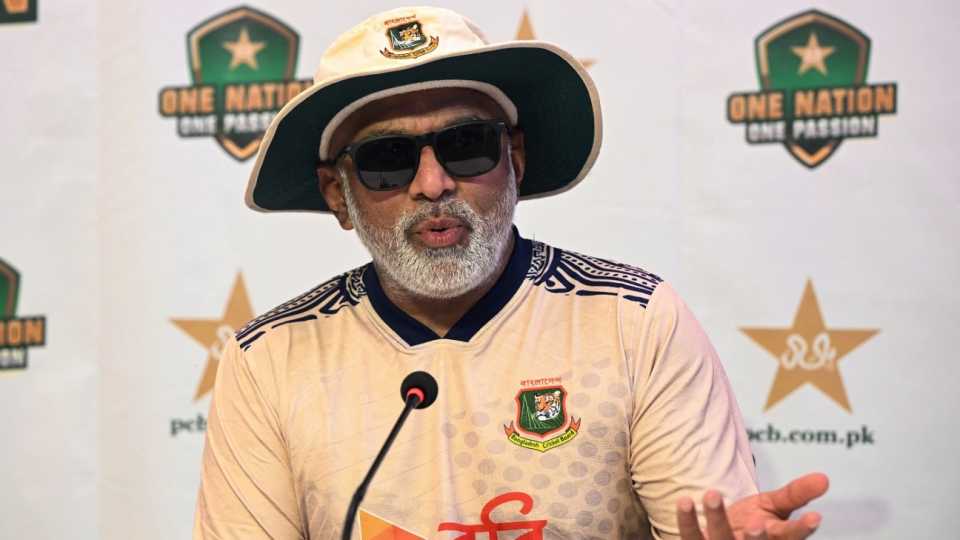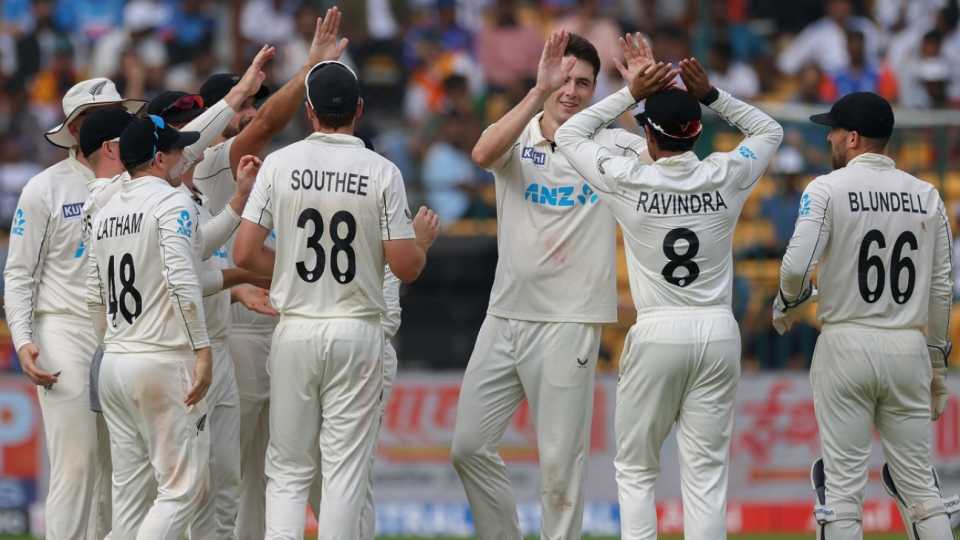Sports
Hathurusinghe questions BCB’s motives after sacking

Sacked Bangladesh coach Chandika Hathurusinghe has accused BCB president Faruque Ahmed of making “premeditated” allegations against him – of assaulting a player and breaching his terms of employment. The BCB had on Thursday removed Hathurusinghe as coach of the national men’s team citing those reasons, and appointed Phil Simmons until the Champions Trophy in 2025.
“These allegations appear to me to be premeditated,” Hathurusinghe said in a statement sent to ESPNcricinfo. “On the first day of the new president’s term, he made a public statement expressing his desire to remove the head coach which he acknowledged might involve financial repercussions for the BCB.
“Additionally, I was shocked to receive a ‘show cause notice’ just four hours before the appointment of another head coach, despite the notice stating that I had 48 hours to prove my innocence. This sequence of events raises serious questions about the motives behind these actions.”
The BCB had suspended Hathurusinghe on October 15 for allegedly assaulting a player during the 2023 ODI World Cup and for taking more time off than was permitted in his contract. The board formally terminated his contract on October 17.
Hathurusinghe said the player in question had not reported the incident to the Bangladesh team manager at the time, and that the alleged incident came to light only when a YouTuber “orchestrated the narrative”.
“I cannot allow this presumption [to go] unchallenged without responding,” Hathurusinghe wrote. “I believe it is essential to clarify the facts as I see them surrounding these accusations and present my side of the story. Firstly, the alleged incident purportedly occurred in the players’ dugout or dressing room, a location that is under constant surveillance during World Cup matches…
“Furthermore, if the incident was as serious as claimed, it is perplexing that the player involved did not report the incident to the team manager or any authority immediately following the alleged event. If a complaint was made, I wonder why I was not questioned or approached for my side of the story at that time. It raises the question as to why the narrative was orchestrated months later by an individual on YouTube?”
The BCB’s second allegation against Hathurusinghe was taking excessive time off. ESPNcricinfo has learned that he reportedly took 112 days off in 2023 and 59 in 2024, when his contract allowed him only 45 days of leave in a year. Hathurusinghe said he had been granted leave by BCB chief executive Nizamuddin Chowdhury and the cricket operations committee chairman Jalal Yunus.
“I have consistently sought and received approval from both the CEO and the chairman of cricket operations whenever I have taken personal leave,” he said. “At no time did the BCB tell me that they were unhappy with my leave situation, but conversely, every time I asked for leave, it was granted by BCB. At no time did I go on leave without their authorisation.
“When the new board members alleged that I had taken excessive leave, they did not account for public holidays, such as Eid, nor the Fridays which may have occurred during my leave. Nor did they give credit for when I did not take allowed time off during public holidays. As I understand it, according to Bangladesh labour law, I am entitled to ‘time in lieu’ for work done on Fridays. Additionally, as a BCB employee, I am entitled to leave on Fridays and a half-day off on Thursdays.”
Hathurusinghe: I was advised to leave Bangladesh on security grounds
Hathurusinghe said he had left Bangladesh for reasons of security, and questioned the BCB’s treatment of its employees and the motivation of the new board administration, which was put in place following the overthrow of the Bangladesh government in August.
“Given the circumstances, I was advised to leave Bangladesh on security grounds,” Hathurusinghe said. “The combination of these allegations, the swift appointment of a new head coach, and the apparent lack of due process raises significant concerns about the motivation of the new management and the treatment of employees within the BCB.
“I am committed to defending my reputation and will cooperate fully with any investigation into these matters. In the end truth will prevail, and I can continue to contribute positively to the sport I love.”
This was Hathurusinghe’s second stint as Bangladesh coach. He was appointed in 2014 and stayed for three years before resigning in October 2017. He returned in February 2023 and was sacked with five months left in his two-year term
(Cricinfo)
Sports
Sammy calls 2-1 series loss ‘moral victory’ on turning tracks in Sri Lanka

West Indies head coach Daren Sammy has declared a “moral victory” for his side in the aftermath of the 2-1 T20I series defeat to Sri Lanka, and questioned the wisdom of the home side pivoting to turning tracks for the final two games, both must-wins for Sri Lanka.
In a fairly scathing assessment, Sammy argued that while the next T20 World Cup – in 2026 – was going to be co-hosted by Sri Lanka, such turning tracks would not be the norm with the ICC having primary input over the curation of the wickets.
“For us, to see the last two games, and the nature of the wicket from what it was at the start, I thought we actually won the contest,” Sammy said following the third T20I which Sri Lanka won by nine wickets. “Because we were the away team and in conditions set before us, we challenged them with a squad that was not our full squad, and they had to react to that.
So I told the guys, ‘yes, when the World Cup comes we won’t get these conditions – the ICC will make sure the pitches are good’. So it was a moral victory for us from the first game to the second game.”
While Sri Lanka may no doubt contest Sammy’s views, it wasn’t long ago that many within Sri Lanka’s camp were themselves clamouring for more batter friendly pitches. The calls had followed Sri Lanka’s dismal display in the 2023 World Cup in India, where their batters struggled to match the attacking approach of the top sides. This plan seemed to have taken root, to a fair amount of success, in the early part of the year where high scores were seen more frequently – particularly during the series against Afghanistan where Sri Lanka narrowly failed to chase down a target of 210.
Fast forward to the present, and Sri Lanka have just enjoyed their first-ever T20I bilateral series win against West Indies, which itself followed an ODI series win against India. Both triumphs have, however, taken place on turning tracks, which has brought up the uncomfortable question: are short-term results being prioritised in place of long-term gains?
Sri Lankan captain Charith Asalanka – who had been one of those calling for better batting tracks – doesn’t think so, as he instead opted to focus on Sri Lanka’s strengths, in this case their spin bowling.
“Sri Lanka’s strength has always been spin, and we still believe that it’s with spin that we will be able to win the most,” he said following Sri Lanka’s win in the third T20I. “So we made pitches to support that strength. When that’s working for us, I think it’s a lot easier for us to win.”
Asalanka’s point is a valid one in many ways. In Maheesh Theekshana, Wanidu Hasaranga and Dunith Wellalage. Sri Lanka boast a spin attack that would be the envy of most sides in the world, and so playing to those strengths makes sense. Sammy, though, believes this could be to the detriment of their fast-bowling contingent.
“When you have pacers, like the two slingers (Nuwan Thushara and Matheesha Pathirana) not getting an opportunity to bowl on good wickets, when the true test comes that’s where you really test your team.
“I mean, there’s home advantage, but what good does that make for the development of your squad, especially your fast bowlers, in being able to bowl and have an impact on the game?”
Sammy’s point holds some merit. In the final T20I, both Pathirana and Thushara bowled just two overs each, with the former being introduced as a seventh bowling option – after both part-time spinners Asalanka and Kamindu Mendis. In contrast, in Sri Lanka’s series win earlier in the year against Afghanistan, only two spinners had been used in each game.
And this might be where Asalanka and Sammy perhaps can find some common ground. While Asalanka has championed Sri Lanka’s spinners, he too acknowledges that they need to bolster their fast-bowling ranks.
“We have a lot of fast bowlers on our bench. Today you saw Nuwan Thushara and Matheesha Pathirana, and they bowled well when called upon. As a team, however, we need our fast bowlers to improve a little more. Aside from those currently in the side, we need more coming in. That’s how we will be able to play well in any conditions.”
Bowling and pitches aside, one immutable fact is that Sri Lanka’s batters turned up more often than did those of West Indies. Sammy, who had stated ahead of the series that he was looking to test their squad depth, is keenly aware of the improvements that need to be made on that front.
“We came here with the T20 World Cup I think less than 20 months away. Having seen the way we played on a typical Dambulla wicket – what we expected from what all the stats said – I thought we dominated.
“We started the series with a squad looking to see the depth, and the home side had to change the whole set-up to make sure that their spinners got the advantage. Ideally, yes, our men did not respond well to the spin. However, with the mindset that we have in our team being a championship winning team, we must be able to play in different conditions. You know, by letting [our] bowlers be challenged and also our batters be challenged.”
Asalanka, for his part, had no such qualms about his batters. Indeed, the scores over the course of the West Indies T20Is indicate that Sri Lanka’s batting has been performing well – they scored at least 160 in each game – despite the nature of the tracks.
“We were expecting a spinning wicket in the first game as well, but it didn’t play as we expected,” Asalanka said. “Then in the second game it turned a lot more, but we still managed to score 162, and in this game we chased down 163 in 18 overs. I think, if you look at the scores you can’t really say it’s a bad wicket.”
But what about on better tracks? While that is a question that can only be answered definitively once Sri Lanka have to deal with such conditions, Asalanka is confident that their batting line-up is primed to deal with whatever challenges are put before them.
“As a team, our goal is that if we get a good wicket abroad, we should be able to score 200-250, but if it’s a harder wicket then we should be able to score 160-170 or in that range.
“Against India, we were chasing 200 or so, but after a good start we were unable to finish it off. Even in the last game, we were on the verge of winning but then our set batters were unable to finish the game. On pitches like this it’s important that the batter that is set, as much as possible, takes the game long or finishes it off.”
(Cricinfo)
Latest News
India flex batting muscle before collapse to set New Zealand 107

Test cricket showed off in all its glory as India, led by the impish Sarfaraz Khan and Rishabh Pant, threatened to pull off the unthinkable in an audacious manner, but the second new ball claimed seven wickets for 62 runs to leave New Zealand 107 to win their first Test in India in 36 years. That is incidentally the lowest target defended in India, but on a rank turner in Mumbai in 2004-05.
This was Test cricket shorn of all of its niceties. The bowlers were under extreme pressure from Sarfaraz and Pant, who added 177 in 35.1 overs, as India tried to become only the second team to win a Test from a sub-50 first innings. This same approach resulted in a collapse when the second new ball started to nip around. This was high-variance Test cricket. India lost 17 wickets for 108 runs to the first and the third new balls, but scored 400 for 3 in 80 overs in between.
India’s quick scoring rate meant the second new ball was New Zealand’s absolute last roll of the dice. Had they failed to cause any damage with the new ball, the best they could have hoped for was a draw. Keeping in mind how they had been pummeled and made to look toothless for 80 overs, it was a show of remarkable skill and persistence with the new ball to roar back into the match.
In under 20 overs, they drew 43 false shots from India, having done so only 72 times in the first 80 overs. Much of it was down to Sarfaraz, swinging his bat hoping to blast the new ball, but who dare question that approach when he scored 150 showing similarly scant regard to the bowling. Pant himself tried to hit his way out, gloving a sweep off Tim Southee, slog-sweeping him out of the stadium, but then playing on the 6’6″ William O’Rourke with the replacement ball on 99, his seventh dismissal in the 90s to go with six hundreds.
O’Rourke was fiery, 3-3-0-3 at one point with the new ball, before Matt Henry found just the optimum seam to take out the last three. It showed just how far you fall behind when you get bowled out for 46. Sarfaraz and Pant carried on from the 231 for 3 on day three, and managed to one-up the progress. Team-mates at the Under-19 World Cup, they were innovative and thrilling.
Sarfaraz turned his first Test hundred into a 150, his 11th first-class score of 150 or more out of his 16 hundreds. Pant, who missed the keeping duties with a knock on his surgically repaired knee from his life-threatening road accident, matched him in audacity. However, his running hampered, he turned at least two couples into singles as he approached the hundred. He walked back with a wistful look at the sky.
If Sarfaraz toyed with the bowling with late-cuts and ramps while ducking and weaving, Pant slog-swept fast bowlers and charged at them to hit them past mid-off. His five sixes took him past Kapil Dev and placed him sixth in the list of top six hitters for India in Tests.
Before the new ball, the only time New Zealand came close to a wicket was a run-out opportunity at Pant’s end, but Tom Blundell reprieved him for the second time in the match by leaving his base to collect a wide throw, seemingly unaware of the opportunity at his end. Pant was on only 6 then.
As Pant felt his way into the innings, scoring 12 off the first 24 balls he faced, Sarfaraz took only six balls in the morning to bring out his cheekiness: a nonchalant ramp off O’Rourke’s first ball of the day. When they reinforced the field with a deep third and a deep point, Sarfaraz still bisected them.
Soon Pant joined him. They showed little regard for the field-sets, no fear of making mistakes, and the New Zealand bowlers again failed to provide Tom Latham any control. The biggest disappointment was Ajaz Patel, who turned the ball less than the part-timer Rachin Ravindra.
It seemed the seam bowlers wanted to trap Sarfaraz lbw, but that only kept giving him easy singles on the leg side. When the keeper came up to the stumps to root Pant to the crease, the visitors were rewarded with an edge but the dying pitch didn’t have enough in it to make it carry. Soon, though, he lofted Southee from the crease for a six back over his head.
In the eighth over of the day, Sarfaraz punched Southee to deep cover for what would have been a single for any other batter, but he had sent all the fielders back with his late-cuts. The boundary brought up an emotional hundred.
When Ajaz got one to kick at Pant from the rough, the glove absorbed a lot of the impact and the ball went straight down. He now decided he had to attack. In one dramatic Ajaz over, he hit two sixes. Then he survived an inside edge and an outside edge in the same over. The inside one saved him from lbw, and his back pad denied New Zealand a catch off the outside edge. Pant still managed to hit one more four in the over, India’s 47th boundary, more than the runs they scored in the first innings.
A shower brought them some relief, but India kept attacking before the new ball, taking their run rate back up to five an over. At first, it appeared New Zealand had exhausted all their luck in getting the conditions to bowl India out for 46 and in getting Rohit Sharma out in the second innings. For now, everything just started going past the bat or falling safe.
Sarfaraz survived seven various kinds of false shots before he finally lobbed one to cover as the ball seamed away from him. Pant, not quite at home himself against the new ball, tried a sweep before actually dropping jaws on the floor with the slog-swept six to go into the 90s.
Then came O’Rourke, who had been ramped for four first ball in the morning. This time his first ball nipped back and kicked at Pant to take the fatal bottom edge to silence the crowd. His extra bounce and seam movement away also accounted for KL Rahul. Then one came slowly off the surface to take the toe end on a Ravindra Jadeja pull.
Henry bowled an unbroken 10-over spell to keep a lid on the scoring and take the last three wickets to go with his first innings’ five. While the India fans had gone from praying for the rain to stop to now hoping for biblical thunderstorms, India didn’t seem pleased when they were asked to go off early for bad light, which did later turn into a massive storm. The new ball was moving, and India were hoping for some damage under artificial lights.
Brief scores:
New Zealand 402 and 0 for 0 need another 107 to beat India 46 and 462 (Sarfaraz Khan 150, Rishab Pant 99, Virat Kohli 70, Rohit Sharma 52; William O’Rourke 3-92, Matt Henry 3-102)
(Cricinfo)
Latest News
Noman Ali eight-for seals Pakistan’s first home win since 2021

It had been a long time coming for Pakistan, but the conclusion was swift Noman Ali and Sajid Khan combined for the second time in the match to bowl out England and seal Pakistan’s first win in a home Test since 2021. Eight wickets fell in less than two hours as England went down in a flurry of sweeps and reverse-sweeps.
Noman claimed seven of them himself to finish with 8 for 46 and 11 for 147 in the match, both career-bests. With Sajid, who took 7 for 111 in the first innings, picking up the other two, they became the first pair to take all 20 wickets in a Test since Dennis Lillee and Bob Massie in 1972.
A crushing result, achieved within three-and-a-bit days on a re-used surface that Pakistan had hoped would help their spinners, means the series is level at 1-1 ahead of the third Test in Rawalpindi. It also provided Shan Masood with his first victory since taking over as captain, after a horror run of six consecutive defeats.
Their success was all the more remarkable given the changes made in response to last week’s crushing innings loss, with Babar Azam, Shaheen Afridi and Naseem Shah dropped and Pakistan selecting a three-man spin attack that had never played together before. In the end, Zahid Mahmood was only required to bowl six overs as Sajid and Noman, playing his first Test since July 2023, dismantled England in tandem.
This was day four of the second Test, but the ninth day of action for the Multan pitch – with three days in between for a quick spritz up – and it was by now offering consistent turn. England’s not-out batters, Ollie Pope and Joe Root, had been practising their sweeps before the start of play and it quickly became clear what the plan of attack was in their attempts to score a further 261 for victory. “Basically getting your broom out,” as Ben Stokes put it afterwards.
Pope, however, didn’t play a shot in anger before becoming the first wicket to fall, poking Sajid’s second ball straight back into the bowler’s hands. Harry Brook attempted to sweep his first ball, Root did likewise and the battle lines were drawn.
Not that such clarity of purpose did England much good. Root and Brook had amassed a record fourth-wicket stand of 454 in the first Test on this pitch but the turnaround in control and composure was stark. Root faced eight balls, attempting to sweep seven of them before being hit on the hip as he stretched out on off stump and played over the ball to be given lbw – a decision confirmed as umpire’s call on review.
Brook got one reverse away to the boundary but his frenetic approach was not built to last and he went back to his 21st delivery, the ball staying a touch low as Noman delivered from round the wicket, to be pinned in front of leg stump swinging across the line. England were 78 for 5, the top order back in the dressing room and the game as good as done.
It was soon 88 for 6, as Jamie Smith top-edged a slog sweep to mid-on three balls after dispatching Noman for four with the same shot. Stokes barely played a straight-bat shot and had the most success, reaching 37 at quicker than a run a ball before he was lured down the pitch by Noman. His swing across the line saw the bat end up somewhere near midwicket as Mohammad Rizwan completed the stumping – a fitting metaphor for England losing their grip.
That was pretty much that, beyond a brief sally from Brydon Carse, who survived being given out lbw to Sajid via the DRS, and subsequently smashed the offspinner for three towering sixes before the guile of Noman induced another swipe and a thin edge to slip. In his next over, Noman plucked out Jack Leach and Shoaib Bashir with consecutive deliveries and Pakistan’s makeshift Multan masterplan had delivered.
Brief scores:
Pakistan 366 (Kamran Ghulam 118, Saim Ayub 77; Jack Leach 4-114, Brydon Carse 3-50) and 221 (Salman Agha 63; Shoaib Bashir 4-66, Jack Leach 3-67) beat England 291 (Ben Duckett 114; Sajid Khan 7-111, Noman Ali 3-101) and144 (Ben Stokes 37, Noman Ali 8-46, Sajid Khan 2-93) by 152 runs
[Cricinfo]
-

 Features7 days ago
Features7 days agoBrands … and brand names
-

 Business7 days ago
Business7 days agoJohn Keells Unveils its 687 room luxury hotel, Cinnamon Life at City of Dreams Sri Lanka
-

 Editorial5 days ago
Editorial5 days agoGenie at large
-

 Editorial3 days ago
Editorial3 days agoMuch-maligned Manape
-

 News2 days ago
News2 days agoChurch not interested in reports sought by Gammanpila: Spokesperson
-

 Sports17 hours ago
Sports17 hours agoOshara making huge strides in cricket in UK
-

 Features6 days ago
Features6 days agoExodus to Italy and its consequences
-

 News7 days ago
News7 days ago‘Cold case’ investigations into past crimes begin says police











